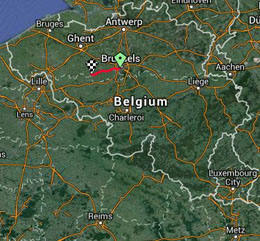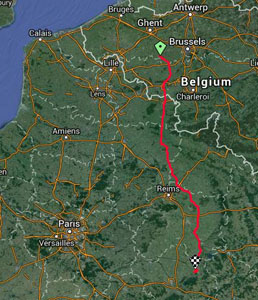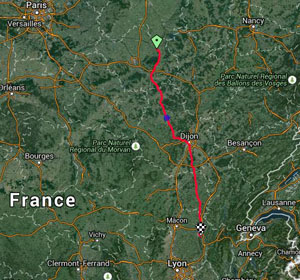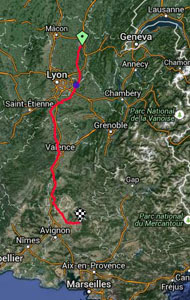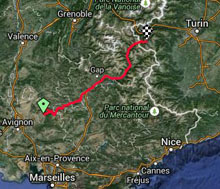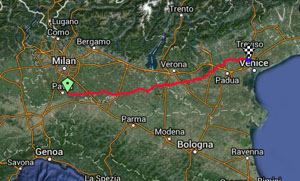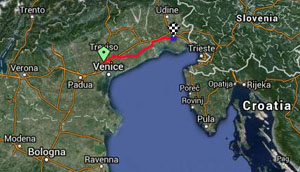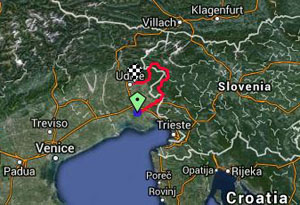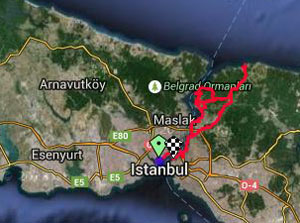This is my ride report from the 2015 Transcontinental Race (TCR). Please visit the Ride Far page dedicated to The Transcontinental Race or the official website if you’re looking for general information about the race instead of a personal race report.
Page Contents:
Pre-Race
Lausanne (Switzerland) – Paris (France) – Brussels (Belgium) – Geraardsbergen (Belgium)
| Distance | 50 km |
| Climbing | 450 m total (9m / km) |
| Moving speed | 22.1 km/h |
| Ride time | 10 hrs incl. stops, 2 hrs moving |
| View on Strava | |
My 2015 TCR was dominated by sciatica pain. I’d had serious problems with a herniated disc in my lower back pinching the sciatic nerve that goes down my left leg about 10-12 years ago, causing me to feel sometimes extreme pain in my leg. I’d been careful since then and the sciatica had been mostly dormant, but it flared up pretty badly during the 4 weeks before the race. Because I was mostly pain-free when riding, I hoped that I could get through the race without it affecting me too much, but I knew that was unlikely.
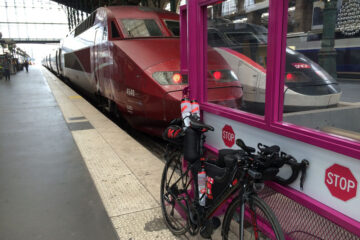
My whole reason for doing the race a second time was to try to RACE it this year. Last year, I’d been quite competitive in the sections when I’d actually focused on progressing quickly, and had several regrets about decisions that I’d made that put me more into tourist mode and taken me away from race mode. I wanted to test myself and see what I was capable of when focusing on racing the whole way. Unfortunately, the sciatica problems had seriously dented my confidence that this strategy would be possible, but I still wanted to try.
Sitting and not moving is one of the worst things for sciatica, so my first challenge was a total of 5 hours on TGV trains from Switzerland, with a change in Paris, and onto Belgium, but frequently walking around in the carriage worked well. In Brussels station, I met Jack, a friend who now lives there, and we rode the 40 km to the start in Geraardsbergen together.
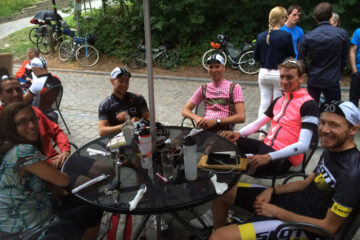
Using Strava’s heat map view, I chose a route on some quieter roads that were quite popular with cyclists. I soon discovered that their popularity was due to the sections of the famous Flandrian cobbles, which were a lot bumpier than I had expected. In fact, the cobbles that we rode on the Muur at the start of the race in Geraardsbergen were far smoother than those that I did to get there, so I’m glad to have had a full Flandrian riding experience.
Once Jack had hung around at the start, attended the riders’ briefing and chatted to several other racers, he was getting quite into the idea of entering next year, so I may have inadvertently corrupted another one! This year, I was responsible for my good friend Alain Rumpf entering the race. Before the start he was worried about whether he had everything that he’d need and whether his body would stand up to the rigors of the race. Little did he know what was actually in store, or that this year’s edition would be way tougher than anyone, even the organizer, had imagined, and that he would push his body to places he could have never imagined beforehand. You can read his race report here.
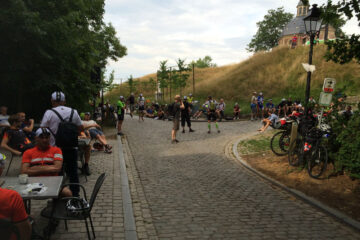
The evening flew by as I chatted with some of the veterans that I knew from last year’s race (including Chris Bennett, John Bakewell, Ellie Solomides, and Mike Sheldrake) and met many rookies. I started remembering what it was like for me the previous year when I had so little idea as to how my body and mind would handle the distances, how the racing aspect would be, and what the riding would be like in the farthest reaches of south-eastern Europe. This year, there were far fewer unknowns ahead so I was far more relaxed.
The start time of midnight approached suddenly, so we lined up on the upper stretch of the infamous cobbles of the Kappelmuur and waited for the town mayor to start the race by ringing his bell.
Race
Day 1: Geraardsbergen (Belgium) – Brienne (France)
| Distance | 336 km |
| Climbing | 2700 m total (8m / km) |
| Moving speed | 22.5 km/h |
| Ride time | 20 hrs incl. stops, 15 hrs moving |
| View on Strava | |
The race began with a loop around Geraardsbergen, descending down to the river then through the market square and up the famous Kappelmuur cobbled climb back to the start line. My video of the start is below. The pace was faster than I’d expected for a neutralized start, so I passed many people who took the descent more cautiously than I did. As the climb started, Juliana Buhring, the best female racer in the world for this type of event, came past and I rode most of the climb with her. In the video, she is the one with the white helmet and the headlight pointing straight down.
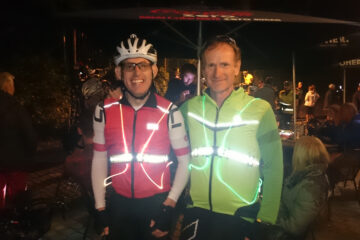
There was a good crowd of supporters at the top of the Muur consisting of friends and families of the racers, plus a few locals who just like watching a bike race while having a beer on Friday night. It was a far more festive send-off than the one at 8am on Westminster Bridge in London last year.
Soon after leaving the Muur, we approached the first intersection. I was ready to go left, but I knew that many others would be heading right. I was surprised by how many people were thrown by already having to make a choice and started frantically fumbling with their Garmins and pulling on their brake levers. I hoped that this would be the first of many parts of the race in which my extensive planning and preparation would allow me to gain some time. I was into race mode and flying off into the Belgian night.
In contrast to my aggressive plans, Alain’s whole strategy was conservative, just wanting to reach Istanbul in time for the party at the end of the 15th day, and to post updates on social media along the way. This conservative strategy extended to the first night when he stopped after 20 km to get a few hours of sleep in a hotel, possibly the only person out of the 175 starters to do so.
Meanwhile, I wanted to get through one large Belgian and one large French town while the roads were empty at night, plus a long section on a big national highway in France, so I planned to ride 120 km before 7am. I had a few mechanical issues along the way, with my front fender coming off due to being too shaken by the cobbles all day, my front derailleur moving out of line when I downshifted, and my headlight being askew. Everything was in order after a few stops and I hoped that the initial high frequency of mechanical problems wouldn’t continue.
I spoke to a few riders during the first hour, including Matt Swain. We had been in touch thru the Facebook group, and I had given him some advice for which he wanted to thank me. I had met a few other people around the start who had said similar things, which was very satisfying. It was also great to see Matt’s excitement at starting this epic journey.

By the middle of the night, I was riding on the same main road in France as most other TCR riders had chosen, so I could see a series of tail-lights up ahead, spaced out with a couple hundred meters between each. There was a slight headwind and when the road tipped uphill, we all ground our way along at about 12-15 km/h, the distances shrank but the time gaps remained almost constant. Being in a slow-motion individual time trial in the middle of the night felt quite odd. However, this was nowhere near as odd as the feelings in my left leg: pedaling wasn’t really causing any pain, but whenever I pushed hard then I got a pins-and-needles and slightly numb sensation in my left foot, plus some odd feelings in my upper leg. I tried not to push it too hard and just kept up a respectable pace rather than trying to race anyone.
When the sun started to lighten up the sky in the east around 5am, my mood improved significantly. The threat of rain and the stiff sidewinds that had been with us all night continued, but each time it rained properly, I managed to find some cover to duck under for a few minutes and stayed mostly dry.
I reached the end of the section on the national highway at the town of Vervins shortly after 7am and looked for somewhere to put my bivvy bag down once I was on the smaller roads. I got an hour or so of sleep and had something to eat before remounting my bike. The terrain was rolling hills through the farmlands of northern France and the stiff sidewinds continued, making the riding never easy.
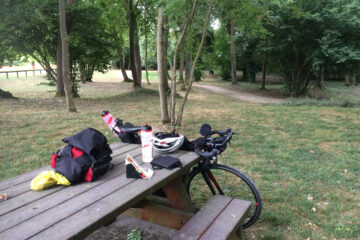
By lunchtime, I realized that my progress wasn’t as good as I wanted it to be and that my sciatica was preventing me from racing the event in the way that I had wanted to and had prepared for. Alain is a far stronger rider than I am on regular-length rides, so I expected him to regain the time that he’d lost sleeping in the hotel quite quickly. However, by late afternoon, the tracker website showed that I’d maintained a similar gap back to Alain ever since I’d restarted following my morning nap. Maybe I wasn’t riding so badly afterall? Plus, my general lack of power and energy could easily be explained by my lack of proper rest, so I planned to stop well before it got dark to get a good night’s sleep.
By 8pm I had been on the road for most of the first 20 hours of the race, so was really pleased to find a hotel with a room because there was nothing available in the region on the Booking.com app on my phone. Some other racers had found the same hotel, and I had dinner with Gregory Barry, a French guy from Lyon who used to be a bike courier and so knows my colleague Blaize.
Day 2: Brienne (France) – Bourg-en-Bresse (France)
| Distance | 302 km |
| Climbing | 2100 m total (7m / km) |
| Moving speed | 23.3 km/h |
| Ride time | 17 hrs incl. stops, 13 hrs moving |
| Previous night | 10 hrs stopped, 6.5 hrs asleep |
| View on Strava | |
I was on the road at 6am the next day and hoping for better feelings in my legs. It was only 7 degrees C when I started, quite cold for July, so I was very pleased that I hadn’t slept in my bivvy bag.
Even after taking it easy for the first couple of hours to slowly warm up, the power still wasn’t coming. I was facing the reality that yesterday’s lack of energy was probably not due to a lack of rest, but was more likely due to my sciatica. I was now riding up the scenic upper Seine river, past the vineyards and wineries of the Champagne region, which you can see in one part of my video of highlights from the first 3 days above. I met Jim Cameron from the Isle of Mull on the road and it was again nice to talk to an excited rookie, but after a few minutes of exchanging stories he pushed on because he was riding much stronger than I was.
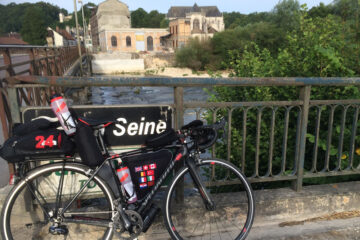
By mid-morning, I started to get a migraine headache, which is quite rare for me. I stopped a couple of times to eat something, to have a lay down, and to try to recover, but nothing was helping. This made me seriously consider whether I should quit the race right there and head home towards Lausanne instead of towards Mont Ventoux. If I continued the race at this steady pace then I could hopefully still finish before the party in Istanbul, but I had already achieved that goal last year, so what was the point of continuing if I couldn’t really race like I wanted to?
Alain sent me a text to ask how it was going since he saw that he’d been catching me quickly all morning. I told him that I was a mess physically and mentally and would be waiting in a bus stop for him to catch me. I spoke to my wife, Heather, who was on her way to the race’s first checkpoint, Mont Ventoux in southern France, to help out as a volunteer at the checkpoint. She was very upset for me, but was supportive in any decision that I made. I took an ibuprofen to ease the migraine and had something to eat, which finally made my head feel better. Alain still hadn’t quite caught me, so I decided to put in a few more slow kms. I made it to the top of the climb, near the official source of the Seine river, and I still had to wait for a couple of minutes before Alain arrived. We then descended down to Dijon together and looked for a restaurant to discuss what I would do.
The roadside café that we found was quite bizarre, with an amusing waiter and a Caribbean theme. We were eventually served a very large plate of chicken, chips, and salad, which went down great while we exchanged stories from the first two days. Alain had met a lot of people as he moved up from the very back of the field, and was getting the hang of TCR riding. I decided to at least keep riding until the base of Mont Ventoux, where I’d see Heather and decide what to do about continuing.
It was after 5pm when we got back on the road. Alain had made his goal an Ibis hotel near Bourg-en-Bresse, 140 km away. I didn’t have much confidence in being able to make it that far that evening, so I let him go ahead.
As we exited Dijon, I met a pair of German riders who I had seen the previous day – Matthias and Matthias, and chatted to them briefly. The strong sidewinds were still blowing, and rain squalls were coming and going, so the Matthias’s and I passed and re-passed each other several times as we each stopped to put on and remove rain jackets.
For the first time in the race, I was starting to feel strong and after a couple of hours I was comfortably pushing speeds of 26-30 km/h. About halfway to Bourg-en-Bresse, I passed a McDonald’s and was tempted to stop for my first fix of fast, dense calories with free wifi of the trip, but decided that since my legs were feeling so good that I should keep going, and instead ate an energy bar.
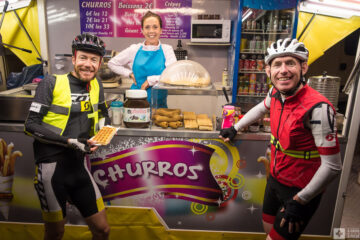
I became confident that I could make it to Bourg-en-Bresse before it got too late, so I thought about staying in the same hotel as Alain. I was surprised to realize that I was actually ahead of him by then, but only because he’d stopped at the McDonald’s that I’d spotted earlier. I continued at a gentler pace; then 15 km before town I found a village with a visiting fairground. Fairgrounds are great because they always have food stands that are open late into the evening and offer fast calories. I got a can of Fanta and a Nutella-covered crepe and waited for Alain to show up, and he soon ordered a caramel waffle.
Alain was now riding with Adrien, a French guy from Annecy who is hoping to participate in the TCR next year. He’d taken a train to the region where we’d started from that morning and had met several racers during the day. He thought about continuing onto Mt Ventoux and then riding home, but he’d developed knee problems during the day. The rain and cold was partly to blame, but he didn’t have anything to wear on his legs, so he had improvised. He’d found some rubber strips on the side of the road and cut out two leg-sized sections, lodged them under the front of his bike shorts, and then tied the rubber together behind his ankles with some string. It was an extremely effective wind and rain shield for his entire legs, but did look rather odd. We told him that ingenuity and problem solving like that would get him a long way in the TCR.
We headed onto Bourg-en-Bresse together, but Alain wasn’t certain exactly where the Ibis hotel was. I found one listed on the far side of town, not far from my planned route, but when we were almost there, Alain announced that he had booked at the Ibis Budget instead of the regular Ibis that we were approaching. It was after 11pm and I wasn’t keen on backtracking to the Ibis Budget since Alain had only booked one single room and there was no guarantee that they had another. So I decided to try the Formule 1 hotel that my Garmin GPS showed to be 2 km out of town in the direction that I needed to head in the morning. After a fast evening of riding, I was in total race mode so wanted to make the optimal decision for my race, so I said goodbye to Alain. Upon arriving at the Forumle 1, I got a cheap room and was very satisfied to have ridden just over 300 km that day despite the terrible middle part and almost quitting.
Day 3: Bourg-en-Bresse (France) – Bedoin (France)
| Distance | 339 km |
| Climbing | 1700 m total (5m / km) |
| Moving speed | 25.4 km/h |
| Ride time | 16 hrs incl. stops, 13.5 hrs moving |
| Previous night | 7 hrs stopped, 4.5 hrs asleep |
| View on Strava | |
I was on the road before sunrise again at 6am and was happy that my legs and energy were continuing to feel good. The wind was still a slight hindrance, but I was looking forward to entering the Rhone valley where it would become a tailwind for the first time.
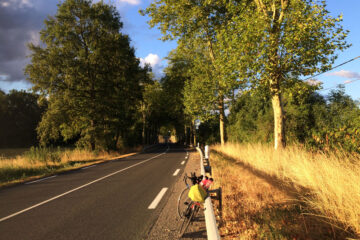
I expected that Alain would catch me soon and when I stopped for a short break after 80km, he was only a few kms behind, but he took a break around the same time. I was now confident that I could make it to Bedoin that evening, so phoned a hotel to reserve a room.
I had an early lunch from a grocery store in Vienne, but just an hour later found a McDonald’s so decided to get my first fix of the trip and a second lunch. After refueling, the anticipated wind was fully behind me and I kept up a good speed all afternoon. Alain and I had ridden this section of the route together back in March, which was handy because there were several options along the Rhone – the large national road, the quieter regional road, a bike path, and occasionally a small back-road that went on and off some of the islands in the middle of the Rhone. We had learnt which parts of the bike path to avoid and which to use, and had a pretty good route plotted using many of the smaller roads.
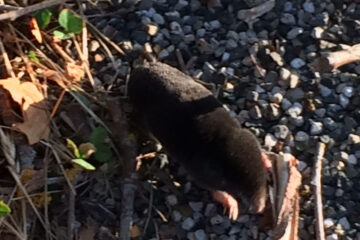
After riding 120 km along the Rhone and crossing it several times, I had to leave it behind and climb towards the base of the Giant of Provence, Mont Ventoux. The road rolled through the Provencale farmlands on some absolutely fantastic roads. It looked like I would arrive at a reasonable time at the hotel, not much after 9pm.
I texted Heather and kept my phone out to take a few photos of the beautiful roads and scenery. I had developed a habit to regularly checking the pouch where I kept my wallet with money, cards, passport, and phone, and when I did so a short while after texting Heather, I panicked because I realized that my wallet was no longer there because I’d left the pouch open when removing my phone! I turned around and went full speed back into the wind that had been pushing me along all afternoon. I sped through Suze-la-Rousse, the town with the best name on the whole route, and saw a couple of other racers, including Gregory who had been in the same hotel as me two nights earlier. They must have wondered why I was riding so hard in the wrong direction, but I didn’t want to stop to say hi or to explain how stupid I’d been.
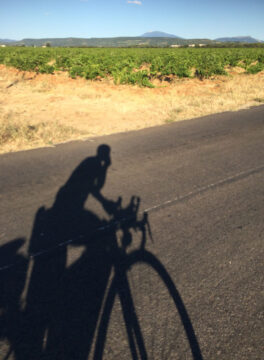
It wasn’t hard to find the spot where I’d pulled off the road and thankfully my wallet was still sitting right there. I’d back-tracked 10 km, so would waste almost an hour in total, but at least I had everything and so was extremely relieved despite being frustrated at myself. I checked my phone messages to see if I’d heard back from Heather, and instead found a message from Alain. In some strange twist of fate, he had just realized that he’d left his passport in a gas station! He’d been able to contact them and they had it, but he would have to ride back 60 km to get it, so now had an extra 120 km to do! I started to feel slightly better about my predicament because his was so much worse, but I felt terrible for him.
I put my head down and rode hard for two hours to get to the hotel. The roads were empty of traffic and everything was beautiful in the evening light, but I arrived a bit after dark, significantly later than I had hoped, and having ridden much harder than I should have for the last few hours.
Despite this problem, things were looking much better for my race prospects. I had done almost 500 km in the previous 29 hours and was feeling fewer and fewer effects from my sciatica while riding. I was still hobbling around when off the bike, but on the bike I had somehow managed to get back to being almost on my initial schedule. For how long could this continue?
Day 4: Bedoin (France) – Mont Ventoux (France) – Sestriere (Italy)
| Distance | 255 km |
| Climbing | 4700 m total (18m / km) |
| Moving speed | 20.0 km/h |
| Ride time | 16 hrs incl. stops, 12.75 hrs moving |
| Previous night | 9.5 hrs stopped, 6.5 hrs asleep |
| View on Strava | |
My decent progress during the first 3 days of the race, in which I’d covered 980 km (610 miles), meant that I’d successfully avoided climbing Mont Ventoux during the hottest part of the day; the temperature when I started at 7:30am was ideal. Unfortunately, my legs were far from the ideal temperature. I had to get straight into the climb with no chance for a warm-up. I was soon into the forest section that has a relentless 9-11% gradient for 8 km. I had some of the lowest gearing of anyone in the race (a 28-tooth chainring with a 32-tooth rear cog), but that wasn’t low enough in my fatigued and slow morning condition, so I had to stop several times to recover. I was amazed by the number of other people doing the climb, none of whom were TCR riders – they were just there to challenge themselves against this legendary monster.
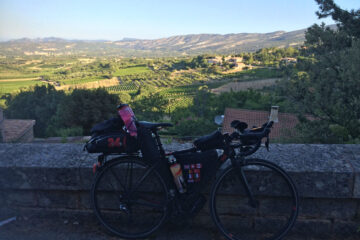
Instead of counting down the kms to the top, my internal countdown ended 6km earlier where I would exit the forest and see Chalet Reynard; I knew that as long as the wind on the exposed ridge wasn’t too fierce, then the worst part of the climb would then be over, so I was very relieved when I finally spotted the café. On the upper stretch, the wind was mostly kind and I waved to a few other TCR riders as they flew down in the other direction.
My wife Heather and several other TCR volunteers were at the top, plus Cols’, a good friend from the shop where I work. Cols’ also came to see me during last year’s Trancsontinental Race on the Stelvio Pass; he really enjoys watching us crazy cyclists.
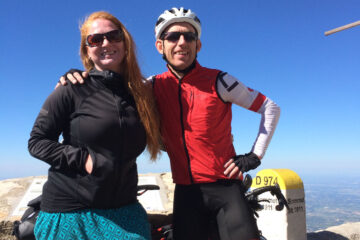
It was wonderful to see Heather. She’d been very worried about me since we spoke on Day 2 when I was considering quitting the race. I’d been feeling much better since then and so quitting was no longer on my mind, but when she saw me hobbling around off the bike, she was still justifiably concerned. I was pleased to hear that she’d been having a great time helping to staff the checkpoint, meeting many of the riders and hanging out with the other volunteers.
My strategy of keeping a decent amount of food and drink on the bike was working well as I didn’t need to stop after the descent and passed many riders in the subsequent villages who were getting supplies. I was waiting until lunchtime for the big grocery store that I had found on a previous ride in the region. Just before then, while going through the magnificent Méouges gorge, I met Rudy, a Belgian TCR rider who subsequently stopped at the same grocery store as me. The Méouges gorge is fantastic, I’ve included lots of video of it in this compilation from my action camera above.
The weather was getting hot, and I remembered how tough I’d found it climbing thru the Durance valley last time I was there, so I took my time having a big lunch at a picnic table with Rudy, not wanting to do too much riding in the heat. An hour after lunch, I stopped again to say hello to a TCR rider who was hanging out at a roadside fruit stand who turned out to be Martin Cox. I’d read his report about last year’s race and he knows Alain quite well because Martin used to live nearby. It was great to finally chat to him about his adventures the previous year.
A strong tailwind blew me up the Durance valley. I was making such good progress and had so much energy that I started to think that I could get to Sestriere that night, hopefully arriving before midnight, which was a goal that I’d never considered possible at the start of the day. Things had certainly turned around since my struggle up Ventoux in the morning.
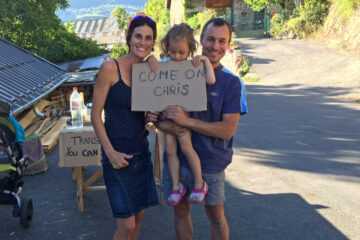
The N94 is the main road up the valley, but in some sections there are also quieter backroads that don’t add any distance. Just after Embrun the extremely scenic D994D follows the opposite side of the valley; halfway along it, I saw a family on the side of the road with a cardboard sign saying “Come on Chris!” I stopped to say hello and discovered that they’d read an article about the race in the local newspaper and were now trying to meet as many racers as possible. They had a table with drinks and snacks and were watching the tracker to see when people were approaching. They were disappointed that only 1 in 10 riders were taking this more scenic option. I refueled with Coke and Pringles, and got all of my three 1-litre bottles filled so that I’d be able to ride almost non-stop thru the evening for 4 or 5 more hours to get to Sestriere.
Shortly before Briancon, I caught up with a pair of female TCR racers, Katie-Jane L’Hepiniere and Jayne Wadsworth. I knew of Katie because she’d been quite active on the TCR forum. She told me that she’d taken quite a lot of my advice about what equipment to bring, which explained why I recognized her Arkel rear bag and her rear-view mirror as being the same as mine. They’d started much earlier than me that day and so Katie was struggling at the end of a big, tough day, whilst I was feeling better than ever, so I pushed on up to the Col de Montgenevre. This pass was a significant point geographically because it not only meant crossing from France to Italy but also moving from the region that drains via the Rhone river towards the Mediterrannean Sea into the drainage basin of the Adriatic Sea via the Po river.
Having attacked the Montgenevre climb quite hard, I took the final climb up to Sestriere very easy. It was 10:30pm by the time I started and the moon was almost full, so I turned off my front lights and climbed the empty mountain road by moonlight. It was one of the most beautiful moments of the race looking at the mountains and valleys that surrounded me in the moonlight.
Day 5: Sestriere (Italy) – Strada dell’Assietta (Italy) – Pavia (Italy)
| Distance | 258 km |
| Climbing | 1750 m total (7m / km) |
| Moving speed | 20.7 km/h |
| Ride time | 16 hrs incl. stops, 12.5 hrs moving |
| Previous night | 10 hrs stopped, 6.5 hrs asleep |
| View on Strava | |
The control hotel in Sestriere offered riders a good price for sharing a room with other racers. After a solid 6.5 hours of sleep, I woke up just after 7am to find myself still alone despite the reception having told me that I would get some room-mates in my 3-person room during the night.
At breakfast, there were many other racers who stayed in the hotel and some had just arrived and were paying to enjoy the buffet. The buffet had started a couple of hours early for us, which meant that several options had already been completely finished, including the eggs and the chocolate cereal. The women’s pair, Katie and Jayne, arrived for breakfast before 8am. I was impressed that they’d already done the two big climbs from Briancon that morning. There’s definitely differences in physiology that cause some people to have energy in the morning like those ladies, whereas I’m far better in the late afternoon and evening.
Before getting on the road, I restocked my supply of sports drink powder and energy gels. The sports store didn’t have any, but they sent me to the small pharmacy across the street. The pharmacy sold what I would later discover were the most disgusting gels ever. Fortunately the drink powder was not too bad, but it didn’t have quite the taste that I’m used to.
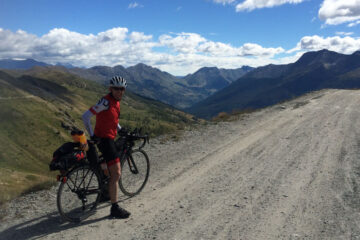
My relaxed morning meant that I didn’t start the Strada dell’Assietta until 9:30am. I knew it was 40+ km on dirt roads at high altitude (above 2000 metres), but based on photos and videos that I’d seen, it didn’t look too much worse than many other such roads that I’d ridden before in the Alps, so I hoped for a maximum of 3 hours. I dropped my tire pressure to maintain some degree of comfort, which was possible without risking pinch flats due to having tubeless tires, I ran 65 psi (4.5 bars) on the front and 75 psi (5 bars) on the rear of my 25mm-wide tires.
I enjoyed the view from the top of the first climb for a couple of minutes with two other riders as we took photos of each other. Soon after, the reasonable dirt road became much rougher. I love these kinds of roads, so had a great time bouncing my way down the descents and crawling up the climbs. I passed many people who were either walking or were stopped to fix punctures. I rode the whole thing, but made much slower progress than I’d hoped, averaging only 11 km/h. You can see what a lot of it was like in this video from my action camera above.
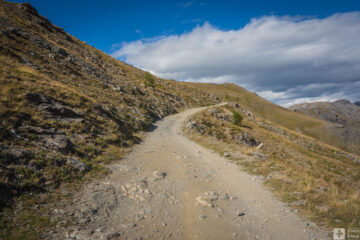
After a few hours, I was getting tired of the rough dirt, so was relieved when I reached the short paved climb up the Colle della Finestre at the end of the Assietta road. I knew that the Finestre descent down towards Susa was also mostly unpaved, but since the pro’ cyclists had climbed it just two months previously in the Giro d’Italia, I thought that it would be reasonably smooth and straightforward. I was therefore disappointed to discover that it wasn’t much smoother than the wild Assietta. Halfway down the Finestre, my luck with avoiding punctures finally ran out as the sidewall on my front tire got cut by a stone – something that even having tubeless tires cannot prevent. I repaired the tire with an internal patch and put an inner tube inside.
Once finally down into the valley, I stopped at a café for lunch before riding into Torino. I was rather discouraged to see that by 3pm I’d only done 70km, but in fact I’d taken less time on that section than most other people and had fewer punctures (there were multiple stories of people having 4, 6, even 10 punctures on the Assietta).
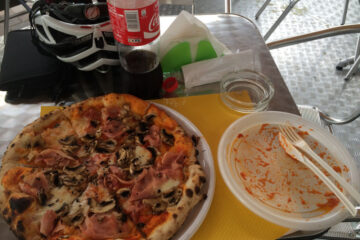
I expected that trying to ride around the northern edge of Torino during rush hour, about 5:30pm, was going to be terrible, but it was not at all bad and once I escaped the city I spotted a place to eat. They had large slices of lasagna ready to be put in the microwave and served hot almost immediately, so I ordered one of those while they cooked me a pizza, half of which I ate there and the other half I saved for later. I’d had a good night’s rest the previous night and saw that some headwind would be arriving the next day, so I planned to keep riding until very late.
I enjoyed my evening ride through the small hills just south of the Po river while most other people took the flatter and less interesting roads north of the Po. After it got dark, I crossed to the north side of the Po and resigned myself to not going over another climb of more than a few meters until Slovenia, about 500 km away.
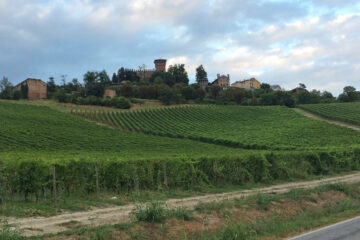
Around 10:30pm, I found a park in the center of a small village where I sat down for a rest and to eat some more pizza. There was lots of activity in all of the villages that I’d passed, even that late in the evening, and it wasn’t long before I had a few kids and one Dad all looking at my bike and trying to ask questions about what I was doing in their terrible English and my even worse Italian.
One of the kids showed my where to find the water fountain, so fully refueled, I got back on the road to do a couple more hours before deciding to get some rest in the bivvy bag just off the side of the road at around 1am. The temperature never went below about 23 C, so I had no need for my sleeping bag, but the bivvy bag was essential to keep the mosquitoes away. Fortunately, I didn’t overheat inside it so had a few good hours sleep.
Day 6: Pavia (Italy) – near Venice (Italy)
| Distance | km |
| Climbing | 1850 m total (m / km) |
| Moving speed | km/h |
| Ride time | hrs incl. stops, hrs moving |
| Previous night | hrs stopped, hrs asleep |
| View on Strava | |

While getting ready to hit the road again at 5am, I saw a few separate TCR riders go past. Due to the ideal conditions, and the time lost on the Assietta section, many people had decided to sleep even less than me. Riding at night had been good for two reasons. First, the roads around Pavia are way too narrow for the amount of traffic that uses them during the day, whereas they are very quiet at night; second, the forecast was correct and a strong headwind picked up a couple hours after it got light. I resigned myself to the fact that I would be riding dead flat roads straight into this wind all day long. I set my target at 300 km because I would then be mostly done with the flat northern Italian plains and would be almost in Slovenia, where I always love to ride.
I rode hard but struggled to keep the average above 22 km/h due to the wind, which was quite demoralizing. I fell farther and farther behind the schedule that I’d set myself, so wasn’t taking many breaks and was constantly pushing hard on the pedals, letting up for just a few seconds meant that the relentless wind would slow me down to a crawl and accelerating again was tough.
One good thing was that I easily found enough to eat and drink; this is often a problem for me when riding in Italy because there aren’t many small grocery stores, those that do exist have odd opening hours, and petrol stations only sell petrol. My Spring training rides in Italy had taught me how to more easily find supplies.
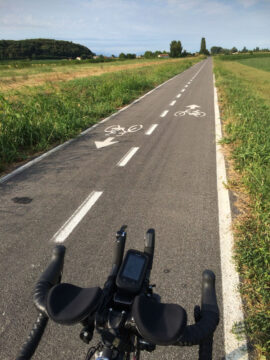
By late afternoon, the wind still hadn’t changed and I was still behind schedule, so I resigned myself to again be arriving at the hotel quite late. When it started to get dark, I was in the suburbs of Venice. I had no idea that the region was so densely populated, and despite never getting particularly close to Venice, I was constantly going through suburbs and medium-size towns for 30+kms. Many sidewalks had been painted to be bike paths, but I avoided riding on those because they always slow me down significantly, and the danger from cross-traffic is greatly increased because drivers are not used to looking for fast-moving vehicles using the bike paths. I prefer staying on the road even if the drivers don’t think it’s a great idea.
I was not enjoying riding in the suburbs in the dark and the headwind was still blowing, so I disappointedly found a hotel 20 km before reaching my target distance. Even so, I’d managed almost 1800 km in the first 6 days including crossing the Alps, and had just about got into the top half of all riders. I was definitely on schedule to reach the finish in time for the party in under 15 days. I was also 200 km ahead of Alain, who’d not only been held up by backtracking to retrieve his passport on Day 3, but had many punctures on the Assietta dirt road on Day 5. Despite having more than enough energy to continue with the pace that I had been doing, I was never sure how much more my sciatica problem might start to hinder me. I was about to find out.
Day 7: near Venice (Italy) – near Slovenian border
| Distance | 281 km |
| Climbing | 350 m total (1m / km) |
| Moving speed | 22.7 km/h |
| Ride time | 16 hrs incl. stops, 12.5 hrs moving |
| Previous night | 4.5 hrs stopped, 3 hrs asleep |
| View on Strava | |
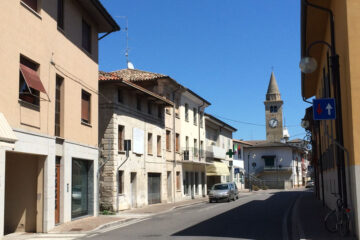
I was doing well at getting up early, often waking after only 5 or 6 hours of sleep, 10-15 minutes before the alarm I had set for 5am. I again got on the road by 6am to get out of the Venice suburbs before the traffic increased and the wind picked up.
Ever since the second half of Day 2, I’d had a decent amount of power in my left leg and my energy levels had been good, but my leg had felt far from normal due to the sciatica. Off the bike, I had to limp around with minimal weight on that leg to avoid the worst of the pain. I’d continued to have only minimal pain on the bike, but the almost constant pins and needles sensations and mild numbness in my foot was uncomfortable and distracting.
Starting in the first hour of this morning’s ride, my leg wasn’t feeling right. By halfway thru the second hour, I knew I was in serious trouble because every pedal stroke caused pain to shoot down my sciatic nerve. In addition, all the strength had gone from that leg; I couldn’t put any force on my left pedal. I stopped every few kms for a few minutes to find some relief, but the pain was at least as bad when off the bike. I took an Ibuprofen, but that didn’t change anything.
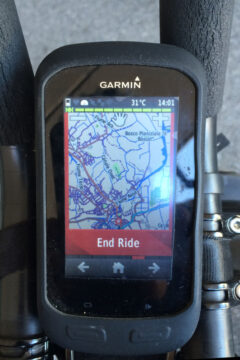
I was barely able to stay above 20 km/h on the flat road so it was pretty obvious that this would be the end of my race. Many people have commended me on making the tough ‘decision’ to pull out, but there was really no decision making involved because there were no other options available. I had no hope of being able to complete my second Transcontinental Race, and if I tried I might continue to do damage to my back. I was devastated but I had no choice but to stop.
I slowly made it to the next major town 25 km away, where I laid down on a park bench and called Heather. She was relieved to hear that I was scratching from the race, which was quite a contrast of emotions to the tears she shed when I talked to her about quitting on Day 2. Laying down for half an hour finally provided my first slight relief from the pain all morning, but I didn’t want to ride any further. However, I really wanted to see Alain that evening before he set off on the rest of his TCR adventure. I called him to give him the news and we decided that he’d probably reach the town I was in before he’d be ready to stop for the night, so I had all afternoon to ride the 30 km to the next town where we’d stay in a hotel together.
On the way out of town, I found a grocery store where I stocked up on food so that I could have a feast once I got to the hotel. Outside the store, I found another TCR rider, Martin Nietzke, and it was good to talk to someone about my disappointment. He’d had more than his share of problems, being hit by a car on a French roundabout causing him to find a replacement rear wheel and was nursing a knee injury.

My gentle ride to the next town was actually quite nice because for the first time in a week I was not in a constant hurry and wasn’t struggling to keep up with a tough schedule. I was just cruising along, going as fast as my body would allow without causing too much pain. I found a gelateria and enjoyed the sumptuous ice cream without feeling guilty that I was wasting time. The server was worried that I was limping around due to a bike accident, but I assured him that my problems had nothing to do with cycling, which was the frustrating part.
I’d been preparing for this for 9 months and had been so ready to see how far I could push myself. Four weeks before the start, I was feeling great and was ready to go then, why did all of these problems have to start?
I arrived at the hotel by 2pm and spent the afternoon resting, catching up with race news, and announcing my scratch on my Facebook page and to the race organizers. I noticed on the tracker that Gregory Barry, whom I’d stayed in the same hotel with on the first night, was approaching the hotel that evening, so I went outside and chatted to him for a while about how his race was going before he continued on.
Alain reached the hotel about an hour later, just after he’d caught Katie and Jayne, who decided to also book into the hotel. Alain had been pleased to have such a firm goal for the day to focus on while battling into the headwind along the flat roads.
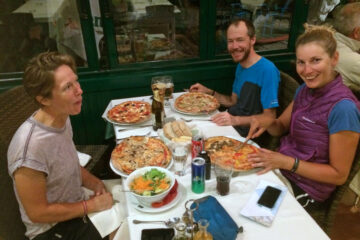
After Alain got cleaned up, we went over to the pizzeria across the street, and by chance, a few minutes later the ladies came in. We had a great chat over dinner, hearing about how Katie’s partner had dropped out just a few weeks before the start of the race, her Mum was not happy about the idea of her racing alone, but luckily she found Jayne through a mutual friend just a week before the start. They hadn’t even met until arriving in Belgium the day before the start. They seemed to have worked out a good strategy of getting on the road at 4am every morning and doing long, steady days.
No-one seemed to be in a rush to finish dinner and get to bed, which I was slightly surprised by, but I discovered when talking to them after the race that this had been an important evening for all of them because they relaxed and left race mode aside for a short time and just enjoyed the adventure and the company. For most people in the TCR, these moments are far more important than is the exact finishing time in Istanbul.
During the afternoon, Heather had decided to drive out from Switzerland to pick me up the next day. Heather and Alain’s wife, Lillie, were flying to Istanbul several days later, and fortunately I was able to buy a ticket on the same flight so that I would be able to see everyone at the finish line.
Post-Race
Slovenian valleys
| Distance | 119 km |
| Climbing | 600 m total (5m / km) |
| Moving speed | 21.6 km/h |
| Ride time | 7 hrs incl. stops, 5.5 hrs moving |
| View on Strava | |
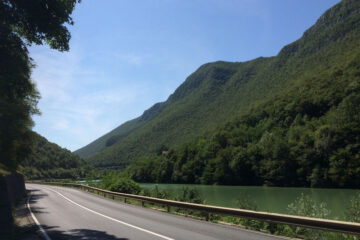
Instead of waiting around at the hotel for Heather to arrive, I decided to go for a gentle bike ride and see how I felt. At a minimum, I wanted to go 10 km to meet up with the route that I’d taken during last year’s TCR when going between the Stelvio pass and the Croatian Adriatic coast. If I could do that then I could probably also get 30km to a motorway pull-off to make it easier for Heather to find me.
I love connecting the lines on my Google Earth map that shows all of the places that I’ve ridden, and so I wanted to ride up the Soca valley into Slovenia to a point where I’d meet the route that Heather and I did when touring there two years ago, which would be about 70 km of riding . In addition, riding in Slovenia is always awesome: great roads, great views, nice drivers, etc.; I highly recommend it.
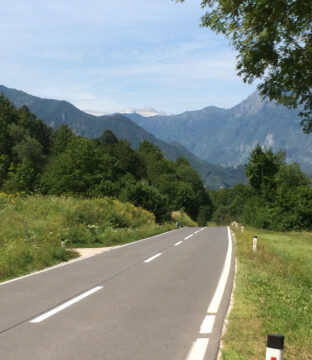
I had a leisurely morning and didn’t get on the road until after 9am. Pedaling still didn’t feel good. There was a lot less pain than the previous day, but I still couldn’t push down on the left pedal. I tried to stand up to accelerate, but my left leg wasn’t holding me up properly, so I had to do all pedaling while seated. There was less wind than the previous 2 days, but when I did have to face it then I was barely maintaining 18 km/h on the flat. This at least confirmed that I had no option but to quit the race.
I still had plenty of energy in my right leg to plod along at a slow pace, so I decided that the more ambitious option of riding into Slovenia was possible. Heather had run into some pretty bad traffic on the Italian motorways, so since I was still feeling good and was loving being in Slovenia, I decided to keep going to the next town. Heather still wasn’t getting much closer, and I saw that after doing 10 km more across a flat plateau, I’d get into the next river valley, from where it would be a gentle downhill back into Italy and directly towards where Heather would be driving in from. So after having a snack at one of Slovenia’s excellent petrol stations, I got back on the bike again. Somehow, by the time I met up with Heather, I’d managed to do 120 km.
Istanbul
| Distance | 101 km |
| Climbing | 1500 m total (15m / km) |
| Moving speed | 19.4 km/h |
| Ride time | 7 hrs incl. stops, 5 hrs moving |
| View on Strava | |
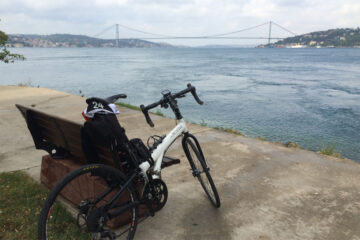
I’m very pleased that I went to Istanbul to see many friends finish the TCR. My parents were also there because they had been hoping to congratulate me crossing the finish line. I was still not able to walk very comfortably, so I didn’t do much of the tourist stuff with them, but they enjoyed exploring the city with Heather and Lillie. I wanted to bring a bike on the plane to get around the city and region without walking much, so I brought my folding bike, an Airnimal Joey, to avoid paying oversize baggage fees.
After riding to Istanbul last year, it was always on my mind that I hadn’t ridden to the Asian side of the city across the Bosphorus. I therefore spent a day rectifying that by riding all the way to a beach on the Black Sea on the Asian side as part of a 100 km-long loop. I still had just one leg doing most of the work, and the route was quite hilly, so it was tough but I managed it.
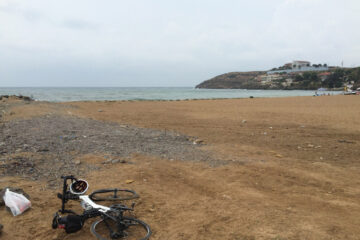
The finishers’ party happens on Day 15 of the race, so I spent all of that day hanging out with the other racers at the finish line café, doing photos in the Rumeli Hisari castle next door, and at the party. The length of the route and the tough weather conditions (headwinds most of the way) meant that many people had to quit due to being too far behind schedule, picking up injuries due to riding so hard for so long, or had other issues that prevented them from continuing. Fortunately, the 30 or so finishers who did make it in time for the party were supplemented by many of the riders who had scratched but had got themselves to Istanbul by some other means. Everyone had stories to share from the previous two weeks, so I had a very enjoyable day.
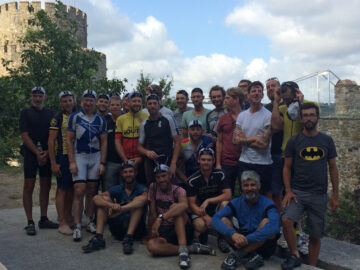
Katie was one of the others who had scratched but still made it to Istanbul. She had literally collapsed in Albania due to exhaustion, and even after a long rest couldn’t continue. She’d done brilliantly up to that point, but had to tell her partner Jayne to continue without her. Jayne eventually became the only woman to finish the race, with all 3 of the women who started as solo riders failing to reach the finish, as did the two women who started with male partners. In fact, only about half of the 175 starters managed to complete the entire race. This compares to the previous year in which 64 of 89 starters finished, 52 of whom did so before the party on Day 15.
Mike Hall, the race organizer, stated that this will likely go down in race history as being the toughest edition ever with the highest dropout rate. He said that the route certainly won’t be any harder in the future and it’s unlikely that such consistently tough weather conditions will be encountered again.

Alain was one of the people who didn’t quite make the party, arriving on Day 16. You can read more about his adventure here. Having been responsible for him signing up for the race in the first place, I was pleased to be able to ride out to meet him 25km from the finish line and do the last section through the forest and along the Bosphorus together, which you can see in the video above. My parents, Heather, Lillie, Alain, and myself then hung out at the café all evening, welcoming in about a dozen riders who finished within a few hours of each other. The next day, we flew home to Switzerland.
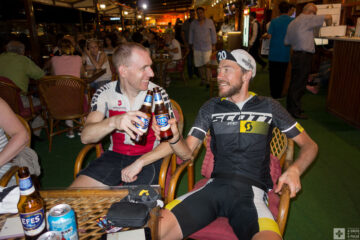
Summary Statistics & Results
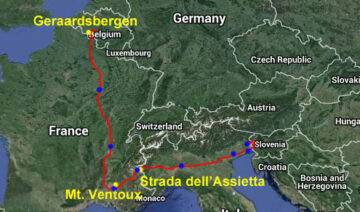
The map on the left (click to enlarge it) shows my (in)complete route, with the start, and intermediate checkpoints marked in yellow and overnight stops marked in blue. More detailed maps for each day are shown with the daily descriptions, so click on the links above to see those.
I rode a total distance of 1,875 km (1,165 miles) during the race with 13,000 metres (43,000 feet) of climbing in 6 and a half days, at an overall riding speed of 22.4 km/h (13.9 m/h). I did an additional 40 km riding to the start and 120 km riding from the point where I withdrew from the race to where my wife collected me, so the trip total was 2,036 km.
My average daily distance was 295 km (183 miles) with 2200 metres of altitude gain, which I completed in an average of 16 hours elapsed time and almost 13 hours of that being on the bike (so 3 hours of breaks during the day). At night, I stopped for an average of 8 hours, of which I slept for about 5 hours
Day 3, in the Rhone valley in France, was my longest, managing 339km (211 miles) in 13.5 hours of riding and 16 hours elapsed time, averaging over 25 km/h. Day 4 was my biggest climbing day with 4700 metres of accumulated altitude gain across the French and Italian Alps.
It’s interesting to compare these statistics to those from my 2014 race. The back problems that I started this year’s race with and the generally unfavorable winds caused my average riding speed to be over 1 km/h slower, but I was still able to ride about 30 km more per day. I achieved this by riding for almost 2 hours more per day, reducing my stops slightly during the day and stopping for 1 hour less each night.
The race results are on the official race website here. I analyzed the data to breakdown how I did, and here are my placings:
- 172 people started the race in Belgium.
- At Checkpoint #1 on Mont Ventoux, I was 111th; 160 riders made it to that checkpoint.
- At Checkpoint #2 at Sestriere, I was 73rd; 158 people made it that far.
- Unfortunately, I had to withdraw before Checkpoint #3.
- 89 people made it to the finish in Istanbul.
I started relatively slowly for the first two days, but then had two very good days, including riding from Mont Ventoux to Sestriere in the fourth best time of the 158 people. My time across the rough dirt Alpine road in Italy, the Strada dell’Assietta, was also good, being the 6th fastest of almost 60 TCR riders whose times are shown on the Strava segment standings. By the time my back really went, I lost all the strength in my left leg, and had to scratch, I was actually in the front third of the field and was on schedule to finish in under 15 days, which in the end only 36 people were able to do.
Withdrawing from the race was obviously a massive negative, but the way I rode until that point gives me massive confidence in what I could do when healthy, but obviously serious regret for what could have been. Hopefully I can learn from my experiences to do even better in 2016.
This page is in the My Bikepacking Race Reports section. The next page in this section is:

